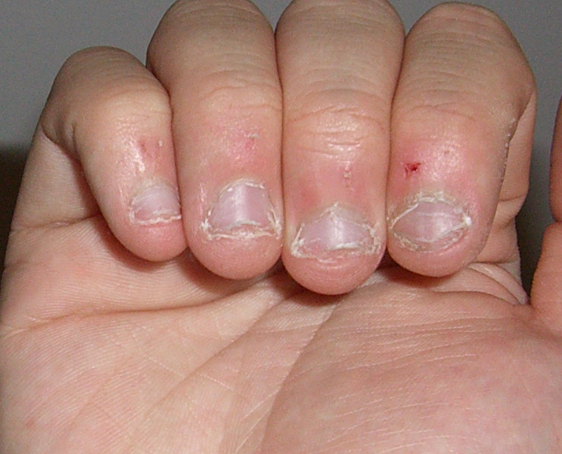
Tuesday morning. I'm staring at my hands over my coffee, noticing the familiar damage from yesterday's biting session. "Right," I tell myself with renewed determination, "today I'm stopping for real this time."
Sound familiar?
By Thursday afternoon, I'd catch myself mid bite during a particularly boring conference call, and that familiar wave of disappointment would wash over me. Again. Another failed attempt to add to the growing pile of times I'd "definitely stopped for good this time."
If you're reading this whilst unconsciously chewing on a fingernail you're probably stuck in the same exhausting cycle I was trapped in for years. The cycle that goes something like this:
Monday: Fresh determination. "This time will be different." Tuesday-Wednesday: Heightened awareness. Catching yourself before you bite. Thursday: First slip-up. "Well, I'll start again tomorrow." Friday: Multiple slips. "I'll start fresh on Monday." Weekend: Complete abandonment. "I'm clearly hopeless at this."
Rinse and repeat for years.
Here's what I wish someone had told me during those years of false starts: You're not failing because you lack willpower. You're failing because you're using the wrong approach entirely.
The Problem with "Just Stopping"
Most of us approach nail biting the same way we'd approach quitting a vice we consciously choose like smoking or drinking. We think if we just have enough determination and remind ourselves not to do it, we'll succeed.
I spent years getting frustrated with myself for "lacking self control," not realising that self-control was never the right tool for this job. It's like trying to fix a leaky tap with a hammer, the tool doesn't match the problem.
The Real Reasons We Keep Starting and Stopping
After years of research, self-experimentation, and far too many failed attempts, I've identified the main reasons we get stuck in this maddening cycle:
1. We're Fighting Symptoms, Not Causes
Most approaches focus on the behaviour itself the actual nail biting. But nail biting is usually a symptom of something else: stress, anxiety, boredom, or even just rough nail edges that trigger the urge to "fix" them.
When I focused solely on not biting, I was essentially playing defence against my own brain. The underlying triggers remained, so the urge would inevitably return stronger than my conscious resistance.
2. We Go from 0 to 100 Overnight
The typical approach: "Right, from this moment on, I will never bite my nails again."
This is like someone who's never exercised deciding to run a marathon next week. Our brains resist dramatic change, especially when it involves breaking patterns we've reinforced thousands of times.
I'd make these grand declarations, last a few days riding the motivation high, then feel like a complete failure when reality set in. The all or nothing approach was actually guaranteeing failure.
3. We Have No Alternative Response
When the urge to bite hits, what are you supposed to do instead? Most of us never develop a specific alternative. We just try to "resist the urge" through sheer force of will.
But your brain initiated the nail biting sequence for a reason stress relief, stimulation, or addressing a physical irritation. Without giving it an alternative way to meet that need, you're asking it to just... suffer. That's not sustainable.
4. We Treat Slips as Complete Failures
This was my biggest mistake. One bite would spiral into "well, I've already ruined it, might as well give up completely." I'd go from one moment of unconscious biting to abandoning the entire effort.
It's like deciding that because you ate one biscuit, you might as well eat the entire packet and start your diet again next Monday. This black and white thinking kept me trapped for years.
5. We Do It Alone
Nail biting feels embarrassing. It seems like such a "simple" thing to stop that admitting you can't makes you feel weak or childish. So we try to change in isolation, without support or accountability.
But here's the thing: isolation is where bad habits thrive and good intentions go to die. The shame that keeps us from seeking support is the same shame that keeps us stuck.
What Actually Works: The Sustainable Approach
After years of stopping and starting, here's what finally broke the cycle for me:
1. Start with Understanding, Not Stopping
2. Build Competing Habits, Don't Just Remove Bad Ones
3. Develop Specific Alternative Responses
4. Treat Slips as Data, Not Disasters
5. Get Strategic Support
Breaking Your Own Cycle
If you're tired of the start-stop cycle, here's what I'd suggest:
Stop trying to quit cold turkey.
Focus on what you want to build, not what you want to stop.
Prepare for slips and plan your response.
Get support, even if it feels uncomfortable.
For Anyone Still Cycling
If you're reading this in the midst of another "failed attempt," please know: you haven't failed. You've just been using approaches that weren't designed for success.
The cycle of starting and stopping isn't evidence that you're weak or hopeless. It's evidence that you need a different strategy—one that works with your brain instead of against it.
You don't have to live with the frustration of constantly disappointing yourself. You don't have to keep making promises to yourself that you can't keep. And you definitely don't have to accept that "this is just how you are."
The cycle can be broken. You just need the right approach.
